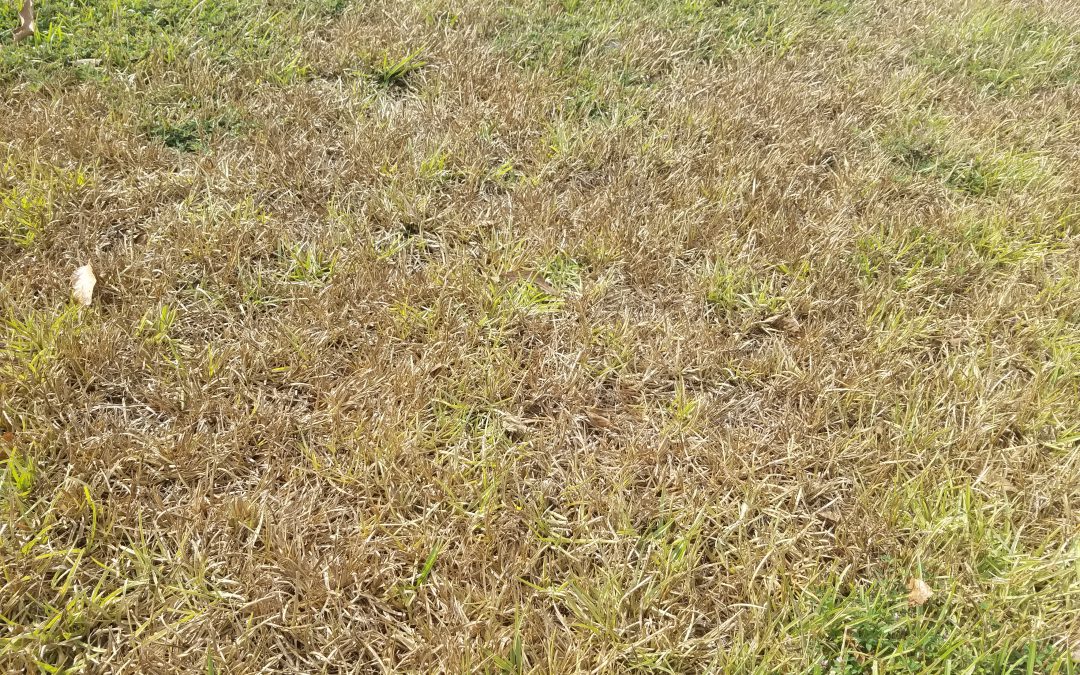
by Daniel J. Leonard | Sep 11, 2025
Many turfgrass yards, including mine, are feeling the effects of an extended droughty period this month. While one of the benefits of the primary turf species grown in the area (Centipedegrass, Zoysiagrass, Bermudagrass, and Bahiagrass), is their drought tolerant nature, they aren’t impervious to drought. Even with these tough grass species the difference between a yard coming out of a drought in decent shape versus dead is as simple as remembering the answers to the following four maintenance questions.
How much should I water to keep my grass alive?
Lawngrass needs about ¾-1” of water per week to remain looking its best and growing vigorously. Obviously, unless you have an irrigation system, keeping a large yard of turfgrass in that ideal water range is going to be hard or impossible. So, what to do? I encourage homeowners to focus their efforts on keeping grass around highly visible and often used areas of the yard well-watered, letting outlying areas fend for themselves until rain resumes. To ensure you’re putting out the optimal ¾-1” of irrigation per watering event, spread a few straight sided cans (tuna or cat food cans work great) under the sprinkler’s range, allow it to run until you reach the 1” mark, and note how long it took to apply that amount of water. This will help you dial in your watering and ensure water isn’t wasted.
Should I mow during a drought?
We all know that an unmown yard looks unkempt. However, given that mowing is a major stress on turfgrass, mowing during a drought can weaken your yard’s ability to recover when the drought ends. If you must mow to keep things looking neat, try to mow only areas that you keep watered and raise your mower’s deck to reduce the amount of leaf tissue you cut from the grass. Mowing in this manner will reduce stress on your turf and keep the yard from appearing weedy and unkempt. My unirrigated Centipedegrass yard has been flowering and setting seed over the last few weeks. My last mowing event (during the current dry period) was designed to only remove seedheads and minimize removal of leaf tissue.

Unirrigated Centipedegrass turf showing drought stress – photo courtesy of Daniel Leonard.
Should I fertilize?
This one is easy! Don’t fertilize grass during a drought! For one, fertilizer promotes growth, and grass isn’t trying to grow during a drought, simply survive. Fertilizing in these times is another unnecessary stress. Additionally, fertilizer requires water to transport nutrients down to the plant roots. If there is no water to do so, it will simply sit there and wait on rain. Also, some or all the nitrogen in the fertilizer applied will volatize and return to the atmosphere, wasting your time, money, and effort and stressing your turfgrass in the process. Hold the fertilizer until rain begins again.
What do I do about weeds?
Turfgrass isn’t the only thing stressed during droughts; weeds are as well. During stressful events like droughts, all plants (weeds included) stop growing and enter survival mode. This has major implications for weed control, as herbicides are not particularly effective on weeds with drought defenses up. In addition to being ineffective, herbicides can injure stressed turfgrass, preventing a healthy recovery post-drought. So, keep the herbicide off the yard until the weeds, and your turf, are happy and growing again.
Maintaining an unirrigated lawn during drought is more about what you don’t do – less mowing and no fertilizer or herbicide applications – than what you do. Mowing too low, applying fertilizer, and trying to control weeds with herbicide are all potential stressors of turf and can inhibit its recovery when the rain returns. The best you can do to keep your lawn healthy in dry times is to apply ¾-1” of water per week and pray for rain! For more information about lawn management or any other horticultural topic, contact your local UF/IFAS County Extension office.
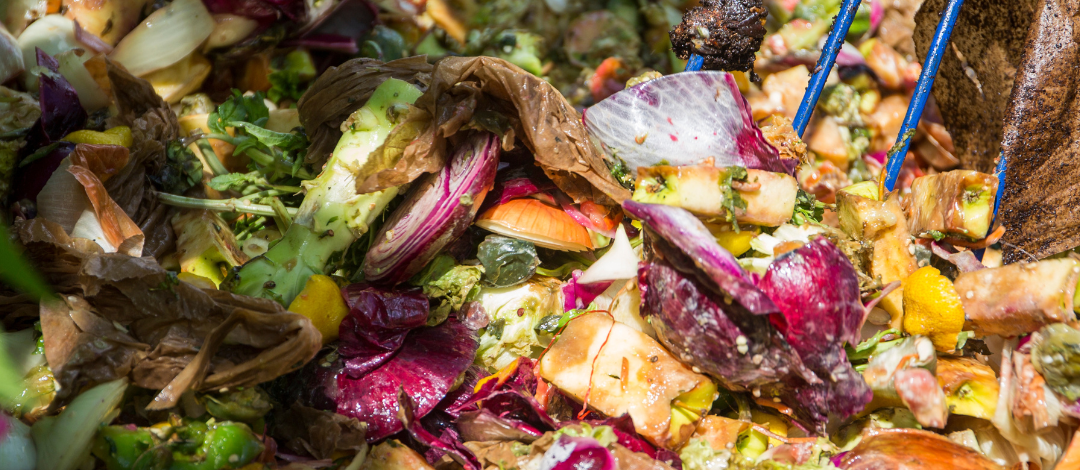
by Abbey Smith | Sep 4, 2025
As we transition from the dog days of summer into (hopefully) the cool weather of fall, it is a great time to consider the nutrient levels of your garden soil. One of the best things you can give your garden is the foundation of healthy soil, but to do that you may have to add some things over time. A natural way to boost your garden’s nutrient levels is through composting. But what exactly is compost and where can you get it?
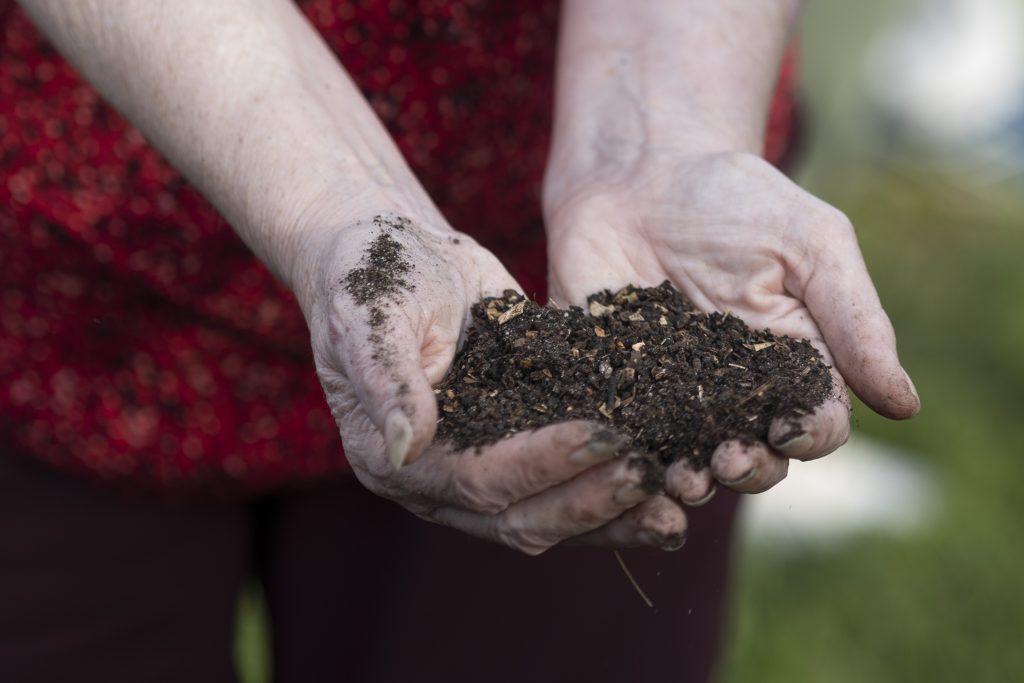
Handful of finished compost soil. Photo Credit: UF/IFAS Tyler Jones
Compost is often referred to as “black gold” by gardeners because of its nutrient dense consistency. And even better, you can make your own compost from home. Compost is the makeup of an even ratio of carbon and nitrogen by-products that naturally decompose over time to create a brown-soil like substance. Carbon products are often referred to as “browns” and nitrogen products “greens.” Examples of browns are straw, cardboard, and old leaves. Green materials are often food scraps, lawn clippings, and animal manures. Compost can be added and tilled into your garden or depending on the type of compost, it can also be used as a potting soil alternative.
It is easy to create a compost bin at home. It does not have to be fancy or expensive to create. Some people opt for a pre-made compost tumbler bin to make turning their pile easier, while others use old wood pallets for their siding. You can even create a vermicompost bin inside a storage tote and use worms to do the composting for you. There are many possibilities. But it is important to note that bins do create a slight odor, because they are breaking down waste products. Location of your bin should be kept in mind if you don’t want close neighbors or even family members making complaints about the smell. However, if there is a strong odor overtaking, it could indicate an issue with the bin and will need to be addressed. Keeping a 1:25 ratio of greens to browns will keep odors at a minimum.
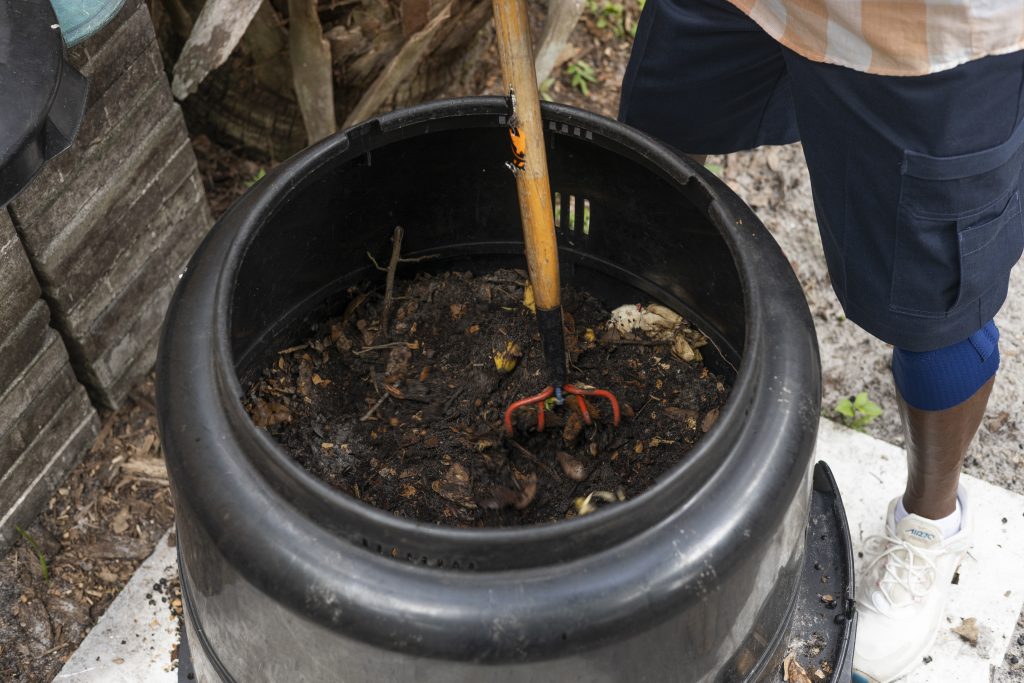
A compost bin being stirred. Photo Credit: UF/IFAS Cat Wofford
If you are interested in hearing more about compost and getting a hands-on demonstration on how to build a compost bin at home, the Jackson County Master Gardener Volunteers are hosting an informational workshop called Backyard Composting 101 on September 20 at 9:00 am at the Jackson County Extension Office. Admission is $7 per person. Space is limited for this class, so be sure to call 850-482-9620 to pre-register today.
For more information, please visit:
https://gardeningsolutions.ifas.ufl.edu/care/fertilizer/compost/
https://sfyl.ifas.ufl.edu/sarasota/natural-resources/waste-reduction/composting/what-is-composting/methods/
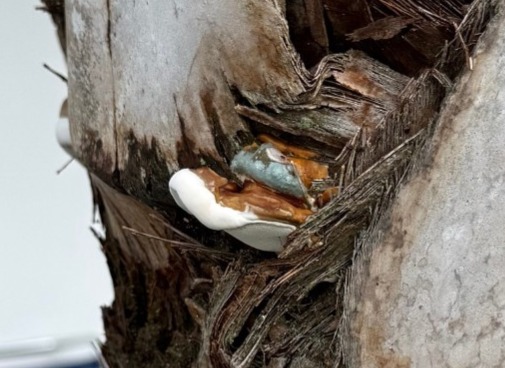
by Evan Anderson | Sep 4, 2025
No plant is as closely associated with Florida as a palm tree – the native sabal palmetto is the state tree, in fact! While this and several other species of palm are hardy even into the cooler regions of the panhandle, there are occasionally problems that arise with them. Palms tend to be sturdy in the wind, handle salt spray, and deal with drought without much issue. A few diseases can strike them, however, and the fungal pathogen Ganoderma zonatum is one of them.
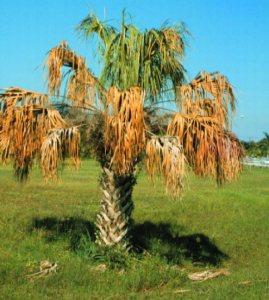
Symptoms of a tree infected with Ganoderma butt rot. Image credit: M.L. Elliott
Ganoderma butt rot, caused by this pathogen, can affect any palm tree no matter the species. It only attacks palms, so nearby hardwoods or conifers are safe from it. As a fungal disease, it spreads by spores, which are produced on a conk (a type of mushroom that is wide and flat, usually growing on decaying wood). By the time the conk is visible on the trunk of a palm, the damage is done. The fungus slowly rots away the lower four to five feet of the trunk, working invisibly until it is ready to reproduce. The trunk of the palm will not become soft or spongy as the disease develops. There may be other outward symptoms of the disease, including slower growth, off-color foliage, and wilting and dying of fronds starting from the older bottom fronds. These symptoms occur with other diseases and problems as well, making it difficult to diagnose Ganoderma butt rot until the conk is visible.
A conk will start out as a small, white, button-like growth on the trunk. As it grows, it expands, flattens out, and develops a brown or reddish-brown coating on top. Old conks turn fully brown. It is uncertain how long it takes a newly infected palm to develop conks; it may be months or even years.
Once a tree is infected with this fungus, there is no cure. Removal of the tree is the only option, and as much of the trunk, stump, and roots as possible should be taken out. Conks may form on stumps after the palm is cut down, which can help to spread the disease. The fungus, unfortunately, persists in the soil even after the palm is removed, so infected palms should be replaced with other types of plants.
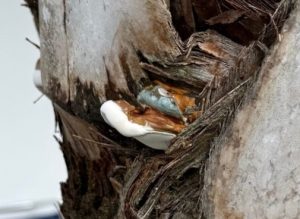
A small, relatively newly formed conk.
Frustratingly, the disease is difficult to predict. There do not seem to be any conditions that favor the disease in particular – it has been observed on otherwise healthy plants as well as stressed ones, and on naturally growing palms as well as those that have been transplanted. Still, keeping plants of any sort as healthy as possible can help them to resist pests and diseases, so fertilize, irrigate, and prune palms properly.
Evan Anderson
Walton County Horticulture Agent

by Beth Bolles | Aug 9, 2025
You have probably heard about the SoilKit testing option that is available at local UF IFAS Extension offices. Why would you want to use a new testing kit when the traditional soil testing kit is still available ?
UF IFAS Extension SoilKit is an option for those who want their turfgrass test results based on the latest evidence-based science. This is especially important when dealing with the application of phosphorus, a potentially polluting nutrient. If your soil measures adequate phosphorus for our warm season turfgrasses, you don’t want to add more.
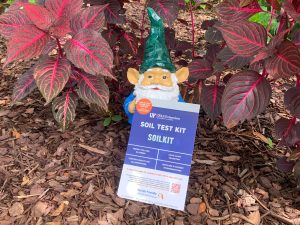
UF IFAS Extension SoilKit. Photo by Beth Bolles, UF IFAS Extension Escambia County.
The good news is that UF IFAS turfgrass research has established thresholds for when nutrients like phosphorus are needed. SoilKit is aligned with these thresholds and will only recommend nutrients based on the evidence-based science.
SoilKit does cost more than the traditional soil testing. The convenience is that it includes postage so you put it directly in your mailbox for pickup. Another positive is that when you register your kit online, you can locate your home on a map and mark the square footage of the lawn area. When you get your results in a few days, there is no guess work. You will get a list of products and amounts to purchase for your size lawn.
SoilKit can be used to test other plant groups including gardens and shrubs. If you have questions about using SoilKit, your local Extension office can help.

by Ray Bodrey | Jul 20, 2025
Sunflowers, Helianthus spp., are a great choice for gardeners who are looking for some cheerful color in their landscape. Here in Florida, we have the main ingredient for success, lots of sunshine!
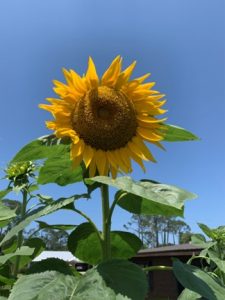
Skyscraper Sunflower. Credit: Ray Bodrey, UF/IFAS Extension.
Sunflowers are short-lived annuals. A good average time between planting and bloom is roughly 65 days. You can typically plant sunflowers in Florida beginning in late winter until early fall. Only the coldest months are the issue, and for most years that’s only a couple of months for us. Sunflowers can be planted almost anywhere there is full sun. The major selling point to plant sunflowers is of course the impressive blooms (figure 1). These yellow to sometimes orange or red petaled flowers develop a central seed disc, with most varieties having approximately an 8” diameter in growth.

Skyscraper sunflowers planted in close pattern. Credit: Ray Bodrey, UF/IFAS Extension.
As for planting, you may choose to plant narrow rows and close seed spacing in order to cull less preforming plants later. A final row and seed spacing of 2’-3’ is recommended for full height and development of most varieties. However, you may choose to plant in a bed, using a close pattern as seen in figure 2. In any event, sunflowers are easy to propagate by seed and are very low maintenance. However, powdery mildew and spittle bugs can be a nuisance. A general garden fungicide and insecticide will help if problems occur.
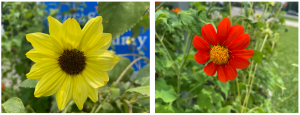
Sunflowers, Helianthus spp. Credit: Ray Bodrey, UF/IFAS Extension.
Sunflowers are available in many varieties, which consists of different color blooms and plant sizes. These sizes range from dwarf (1’-3’) to tall (10’-15’) varieties (figure 2). You may wish to stake taller varieties at some point, as some plants will tend to lean with no wind break in place. Here’s a few gardening variety common names to look for: sunbright, sonja, sunrich lemon or orange and autumn beauty. Seed companies also have mixes available in packets. For tall plants, mammoth or skyscraper varieties exist.
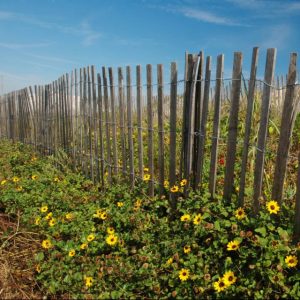
Beach sunflower. Credit: Ralph Mitchell, UF/IFAS Extension.
If you are fond of the sunflower bloom and looking for a groundcover, there are a couple of native perennials that fit this category. Beach sunflower, Helianthus debilis or swamp sunflower, Helianthus angustifolius, are groundcovers/ornamentals for landscapes and thrive in dry, hot climates and in a range of soil types. They also are great pollinator attractors.
For more information, contact your local county extension office. Happy Gardening!
Supporting information for this article and links to other publications can be found at the UF/IFAS Gardening Solutions website: https://gardeningsolutions.ifas.ufl.edu/plants/ornamentals/sunflowers.html
UF/IFAS Extension is an Equal Opportunity Institution.
by Danielle S. Williams | Jul 20, 2025
Black-eyed Susan, Rudbeckia hirta, is a yellow wildflower commonly found throughout Florida. It is easily recognized by its golden yellow petals and dark brown center or its signature “black eye”. Not only is black-eyed Susan a beautiful addition to any landscape or garden, but it is also beneficial to pollinators and easy to care for! A win, win for gardeners alike!
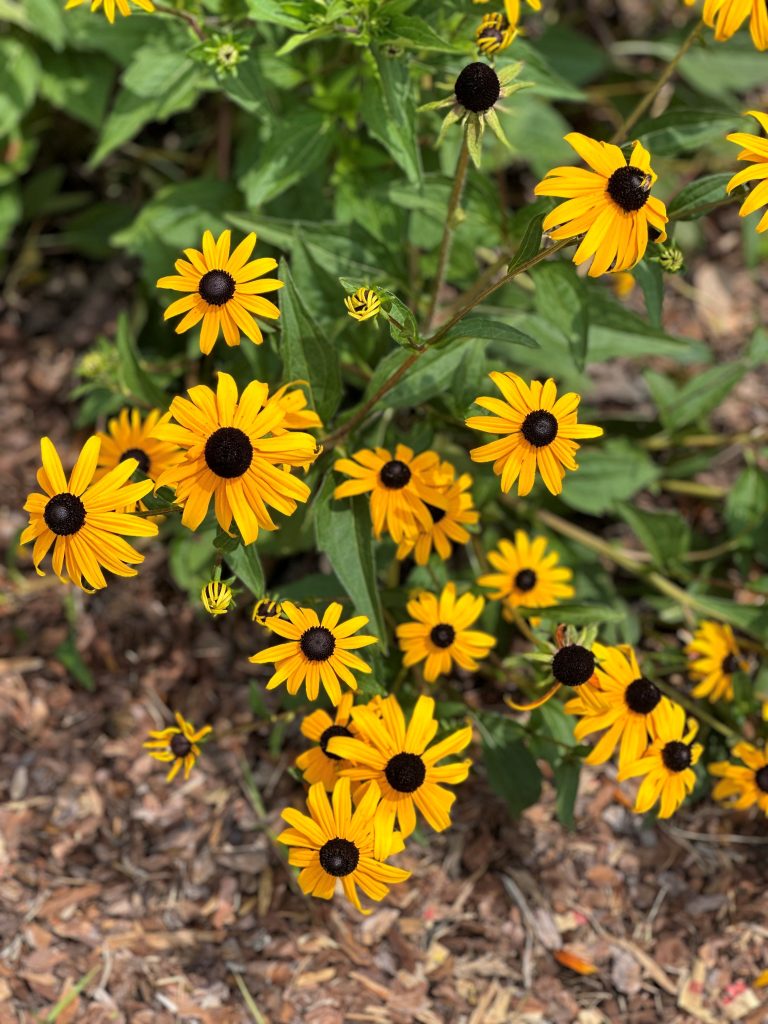
As a native wildflower to much of the eastern and central United States, Black-eyed Susan plays an important role in supporting local ecosystems. It provides pollen and nectar to a wide variety of pollinators such as native bees, butterflies, hoverflies, and other beneficial insects. Its long blooming season provides a food source to support these species during the hot summer months when many other plants are not blooming.
One of the greatest appeals of Black-eyed Susan is its versatility. It can be grown in full sun and well-drained soil but will tolerate poor soil, drought and even some shade. After establishment, it requires minimal care and returns each year.
Growing Considerations:
- USDA Hardiness Zones 2-11
- Soil pH range: 6.0-7.2
- Soil tolerances: clay; sand; acidic; loam
- Plant spacing: 12 – 28 inches
- Moderate drought tolerance
- Flowering months: May – October
- Growth height: 1-3 feet
If you’re looking for a resilient, beautiful, pollinator-friendly flower that brings bold color during the summer and is easy to care for, Black-eyed Susan is a great option!


















